RT-15: the history of the creation of the first self-propelled ballistic missile of the USSR (part 1)
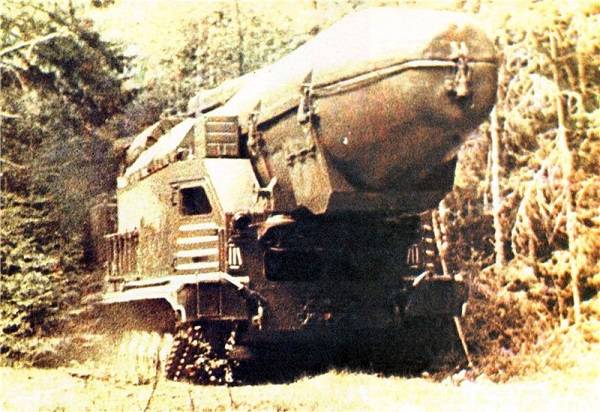
The first prototype self-propelled launcher complex 15P696 on field trials. Photos from http://www.globalsecurity.org
"Land submarines" - what can be hidden behind this strange, at first glance, term? Academician Boris Chertok, one of those people who created the domestic rocket industry, called this phrase mobile earth rocket systems - unique weapons, which the main opponent of the USSR in the “cold war” could not copy.
Moreover, the term coined by academician Chertok hides much more than just an analogy with submarine rocket carriers. The United States, having failed after the creation in the Soviet Union of such missiles as the UR-100 and P-36 family and its successor, to restore parity in the land-based intercontinental ballistic missiles, relied on nuclear submarines. It is clear that the submarine, whose location in the ocean is very difficult to establish, is almost an ideal platform for storing and launching ballistic missiles. Moreover, they can be made not too long-range - it is enough to sail to the shores of a potential enemy, and from there even a medium-range missile will finish almost to any place.
Having failed to create an equally powerful nuclear missile fleet, the Soviet Union found its answer to the American approach - mobile missile systems. It is not by chance that the Molodets railway combat missile system frightened overseas strategists so much that they insisted on its categorical disarmament. But no less a problem for reconnaissance and, accordingly, targeting of ballistic missiles are mobile complexes on a car chassis. Go find such a special car in the vast expanses of Russia, even if it is twice the size of a regular truck! And satellite systems can not always help with this ...
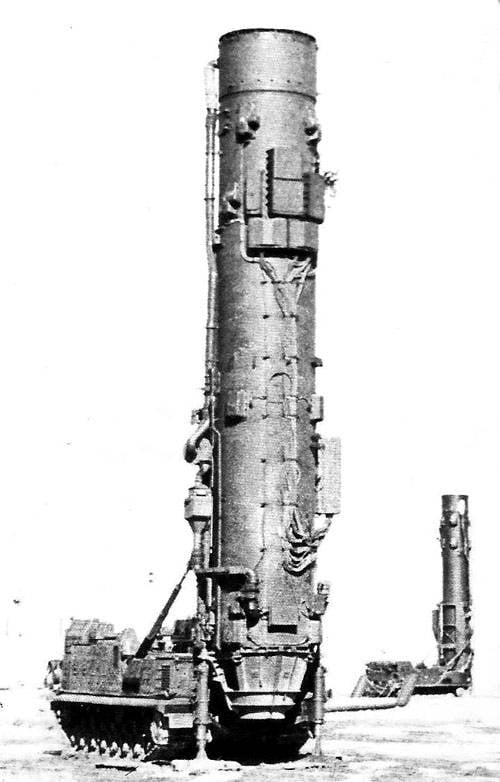
Self-propelled launcher of the mobile missile system 15P696 with a rocket RT-15 in combat position. Photos from http://militaryrussia.ru
But the creation of mobile BRK strategic purpose would be impossible without the appearance of solid-propellant rockets. It is they, who are lighter and more reliable in operation, have allowed the development and launching of land-based submarines of the Russian Strategic Missile Forces into mass production. And one of the first experiments in this direction was the mobile 15P696 ground-based missile system with the RT-15 rocket - the first (along with the “mother” RT-2) medium-range commercial solid-propellant in the USSR.
Liquid to the detriment of solid
Despite the fact that before the beginning of the Second World War and during it, the priority in the development, and most importantly - in the practical use of rockets on solid fuel engines belonged to the Soviet Union, after the war he lost it. It happened for a number of reasons, but the main one was that the gunpowder on which the shells of the legendary Katyushas were flying was completely unsuitable for large rockets. They ideally dispersed the missiles, if their active leg of the flight took seconds. But when it came to heavy rockets, in which the active site takes dozens, or even hundreds of seconds, domestic solid-propellant rocket engines (RDTT) were not up to par. Moreover, in comparison with liquid rocket engines, they had an insufficient specific impulse of thrust at that time.
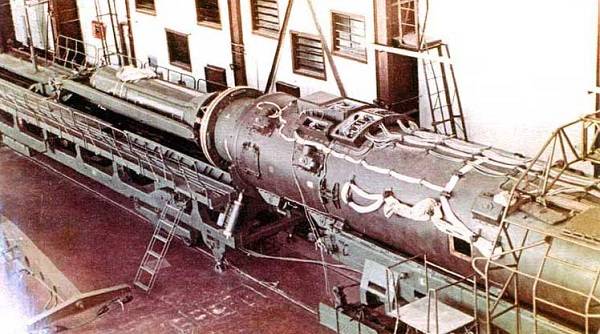
Solid fuel rocket RT-15 in a shipping container at the plant "Arsenal". Photos from http://www.russianarms.ru
All this led to the fact that in the Soviet Union, which got into the hands, even if heavily thinned out by the Allies, still very informative documents and samples relating to German rocket technology, relied on liquid-propellant engines. It was on them that the first Soviet ballistic and operational-tactical missiles with nuclear warheads took off. At the same engines, at first, American intercontinental ballistic missiles also flew. But - only at first. Here is how Boris Chertok talks about this in his book of memoirs “Missiles and People”:
“Since the times of the classical works of the pioneers of rocket technology, it was considered unshakable that the solid fuel — types of gunpowder — is used in those cases“ when simple, cheap, short-term propulsion is required. ” For long-range missiles, only liquid fuel should be used. This lasted until the beginning of the 1950-ies, while the jet propulsion laboratory of the California Institute of Technology has not developed a mixed solid rocket fuel. It was not powder at all. The only thing common with the powders was that the fuel did not require an external oxidizer - it was contained in the composition of the fuel itself.
Mixed solid fuel, invented in the United States, was far superior in energy performance to all of our gunpowder grades used in rocket artillery. The powerful American chemical industry, with the help of rocket engineers, evaluated the prospects of discovery and developed a technology for large-scale production.
Mixed solid rocket fuel is a mechanical mixture of solid fine particles of oxidizer, metal powder or its hydride, evenly distributed in the organic polymer, and contains up to 10 – 12 components. Oxygen-rich salts of nitric (nitrates) and perchloric (perchlorate) acids and organic nitro compounds are used as oxidizing agents.
The main fuel is metal in the form of highly dispersed powders. The cheapest and most common fuel is aluminum powder. Mixed fuels, even with well-established technology, remain significantly more expensive compared to the best in energy performance liquid components.
When pouring into the body of the rocket, an internal combustion channel is formed. The engine housing is additionally protected from heat exposure by a layer of fuel. It became possible to create solid propellant rocket motors with a working time of tens and hundreds of seconds.
A new technology of equipment, greater safety, the ability of mixed fuels for stable combustion made it possible to produce large charges and thus create a high value of the mass perfection coefficient, despite the fact that the specific impulse of solid propellant rods is even lower than that of the best composite recipes. - liquid rocket engines. However, constructive simplicity: the absence of a turbopump assembly, complex fittings, pipelines — with a high density of solid fuel makes it possible to create a rocket with a higher Tsiolkovsky number. ”
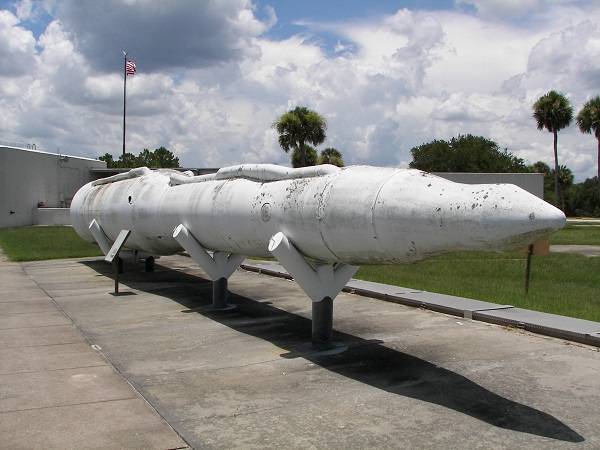
The first American ICBM solid fuel "Minuteman" in the museum. Photos from http://historicspacecraft.com
So the Soviet Union lost priority, first in the creation of intercontinental ballistic missiles, and then began to give way to strategic parity. After all, solid-fuel missiles can be produced much faster and cheaper than liquid ones, and the safety and reliability of solid-propellant solid propellant rocket engines allow you to keep them on alert constantly, with the highest degree of readiness - within one minute! These are the characteristics of the first American MBR on solid fuel "Minuteman", which began to enter the troops at the end of 1961. And this missile required an adequate response - which still had to be found ...
Three impulses for Sergey Korolev
Looking ahead, I must say that the real answer to the “Minutemen” was the liquid “weaving” - the UR-100 rocket, developed in Vladimir Chelomey's OKB-52 (detailed on stories the creation and adoption of this missile can be found here). But at the same time as the "weave", the first solid-fuel Soviet missiles were developed and tested - and also as a response to the "Minuteman". And a man who for a long time was accused of being too strongly addicted to liquid engines, Sergei Korolyov, took up their creation. Boris Chertok writes about it this way:
“Korolev received not one, but three impulses at once, forcing him to be the first of our chief designers and rocket strategists to rethink and change the choice in which strategic missile weapons were oriented exclusively towards liquid-propellant rockets.
<...>
The first impetus for the start of work in the OKB-1 over solid-fuel missiles was the abundant information about the Americans’s intention to create a new type of intercontinental three-stage rocket at the beginning of 1958. I don’t remember now when we received the first information about “Minutemen”, but, having appeared for some business in Mishin’s office, I witnessed a conversation about the reliability of this information. Some of the designers reported to him about the correspondence of the information received to our then ideas about the capabilities of solid-propellant rockets. The general opinion was unanimous: to create a rocket with a launch mass of just 30 tons and a mass of the 0,5 head part to the tonnes at a distance of 10 000 km in our time is impossible. On that temporarily and calmed down. But not for long".
The second impetus for the start of work on solid-fuel missiles, Boris Chertok calls the return to the rocket industry of "the old ally of GIRD, RNII and SRI-88" Yury Pobedonostsev. And the third is the appearance in Sergey Korolev of OKB-1 of another old rocket man, Igor Sadovsky, who once worked in the “rocket” scientific research institute-88. Boris Chertok recalls:
“Sadovsky encouraged volunteers and gathered a small“ illegal ”group to prepare proposals for ballistic solid fuel missiles (BRTTs). The main core is three young specialists: Verbin, Sungurov and Titov.
“The guys are still green, but very intelligent,” said Sadovsky. - I distributed three main tasks between them: internal ballistics, external ballistics and construction. The previous hardware connections helped me, managed to agree with Boris Petrovich Zhukov, the head of the Scientific Research Institute-125 (this is our main institute for rocket and special powders), on a joint theoretical study. And at NII-125, our old general head Pobedonostsev is in charge of the laboratory, where they are already working not only on paper, but are also experimenting to create gunpowder drafts of new composition and large sizes. Sadovsky spoke about his "underground" activities to the Queen.
Korolev immediately agreed with Zhukov and Pobedonostsev about “leaving the underground,” and the development of a project for a medium-range solid-fuel rocket began. ”
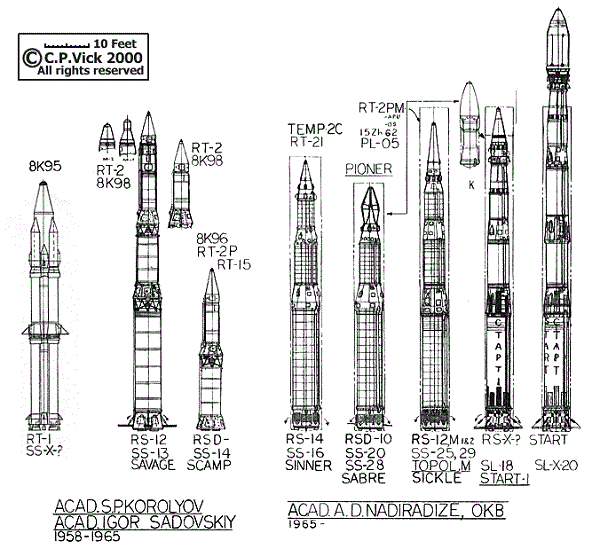
The family of Soviet solid-state ballistic missiles. Photos from http://www.globalsecurity.org
Sergey Korolev managed to attract people to these works who, it would seem, could hardly find themselves in the rocket theme - employees of the former artillery design bureau of General Vasily Grabin, the creator of many legendary artillery systems of World War II (guns ZiS-2, ZiS-3 and others) . Nikita Khrushchev's fascination with rockets led to the fact that the artillery was driven to the outskirts of the arms industry, and the former design bureaus and research institutes on this subject distributed to missilemen. So, about a hundred specialists turned out to be at the disposal of Korolev, who enthusiastically took up the idea of working with solid propellant rocket engines that was quite understandable to them.
All this led to the fact that gradually the work, scattered and seemingly unrelated, concentrated and began to acquire real features. And then, according to Boris Chertov, “in November 1959, the quenching power of the Queen and annoying information from overseas worked at the highest level. A government decree was issued to develop a rocket at a range of 2500 km using charges from ballistic powders with a mass of the 800kg head part. The rocket was called PT-1. This was a government decree on the creation of a solid-fuel fuel tanker in the Soviet Union, whose chief designer was Korolyov. Immediately after the resolution was issued, it was assigned the index 8K95. ”
Solid "two"
Work on the solid-fuel rocket RT-1 stretched for more than three years - and ended, it would seem, a failure. A total of nine missiles were launched, but the results of these tests remained unsatisfactory. In fact, it turned out that the “powder-growers” could only create another medium-range missile - in addition to the already existing P-12 and P-14, developed in the OKB-586 by Michael Yangel. It was clear that the military would refuse to accept it - and it was necessary to take steps to prevent the topic from completely closing.
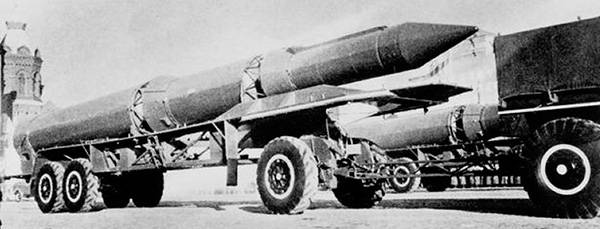
A solid-fuel rocket RT-2 on a transport vehicle during the November parade in Moscow. Photos from http://kollektsiya.ru
Sergey Korolev found this solution by submitting to the government and achieving agreement on a project for a solid-fuel rocket RT-2 - a completely new one for Soviet rocket production. Another quote from the memoirs of Academician Chertok:
“Starting to work on a new topic, Korolev sometimes showed the breadth of the problem, which irritated high-ranking officials. He did not tolerate the principle “we will begin, and then we shall understand”, which was sometimes followed by very authoritative figures. From the very beginning of work on a new problem, Korolev sought to attract as many new organizations as possible, competent specialists, and encouraged the development of several alternative options in order to achieve the same goal.
Such a method of wide coverage of the problem often led to the fact that “on the way” to the final goal other, previously unplanned tasks were solved.
The resolution on the creation of an intercontinental solid-fuel rocket RT-2 can serve as an example of such a broad coverage of the problem. On the way to the final task, two more were solved: of the three stages of the intercontinental rocket were medium and short range missiles. The decree of 04.04.1961 of the year, issued before the end of the tests of the PT-1 rocket (8K95), was prepared for a long time. Korolev patiently conducted difficult and tedious negotiations with new people and leaders of not always loyal departments. The resolution approved and adopted for implementation the original project, which provided for three interconnected solutions for solid-fuel engines, which made it possible to create three missile complexes complementary to each other:
1. Intercontinental missile complex RT-2, mine and ground-based, with a three-stage solid-fuel mixed rocket, at a distance of at least 10 thousands of kilometers with an inertial control system. The rocket of the PT-2 complex was originally intended for a unified warhead with the same warhead that was developed for the P-9 and P-16, with a power of 1,65 megatons. The chief designer of the missile complex by order was Korolev.
2. A medium-range missile system - up to 5000 kilometers, land-based using the first and third stages 8K98. This rocket has been assigned the index 8K97. Mikhail Tsirulnikov, the chief designer of the Perm design bureau of mechanical engineering, was appointed the chief designer of the medium-range complex, he was also the developer of the first and third stages for 8К98.
3. The RT-15 mobile missile system, tracked, with a possible launch from mines, to a distance of 2500 kilometers. The launch launch vehicle has been assigned the index 8К96. For it used the engines of the second and third stages 8K98. The central organization for the development of the mobile complex was identified TsKB-7, and the chief designer - Peter Tyurin. TsKB-7 (soon renamed the Arsenal design bureau) to the beginning of work on rocketry had a great experience in creating artillery systems for the Navy. For all three missile systems, Korolyov was the chairman of the Council of Chief Designers. ”
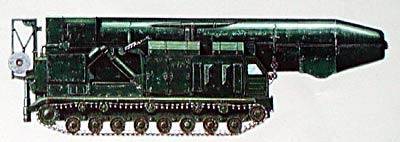
Early prototype self-propelled launcher for the rocket PT-15. Photos from http://www.russianarms.ru
The project of a solid-fuel intercontinental ballistic missile, worked on by the royal OKB-1, eventually grew into the RT-2 rocket and its upgraded version of the RT-2П. The first was put into service in the 1968 year, the second came to replace it in the 1972 year and remained on duty until the 1994 year. And although the total number of deployed "twos" did not exceed 60, and they did not become a real counterweight to the "Minuteman", they played their part, proving that solid propellant engines are quite suitable for intercontinental rockets.
But the fate of the RT-15 was much more difficult. Although the rocket quite successfully passed the flight design tests and was even put into trial operation, as a result, it was not reached before being put into service. The main reason was that the designers of TsKB-7 did not manage to bring the control system RT-15 to a satisfactory state. But as a demonstration of the possibility of creating a mobile missile complex "Fifteen" played its role. And in fact, it paved the way for the 15P645 complex following it - the famous Pioneer developed by the Moscow Institute of Thermal Engineering under the guidance of Academician Alexander Nadiradze.
Продолжение следует ...
Information